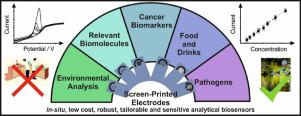Talanta Open ( IF 4.1 ) Pub Date : 2021-01-22 , DOI: 10.1016/j.talo.2021.100032 Alejandro García-Miranda Ferrari , Samuel J. Rowley-Neale , Craig E. Banks

|
This short article overviews the use of screen-printed electrodes (SPEs) in the field of electroanalysis and compares their application against traditional laboratory based analytical techniques. Electroanalysis coupled with SPEs can offer low-cost, precise, sensitive, rapid, quantitative information and laboratory equivalent results. The combined use of SPEs and electroanalysis reduces the need of sample transportation and preparation to a centralised laboratory allowing experimentalists to perform the measurements where they are needed the most. We first introduce the basic concepts and principles of analytical techniques to the reader, with particular attention to electroanalysis, and then discuss the application of SPEs to common analytical targets such as food, environmental, forensics, cancer biomarkers and pathogenic monitoring and sensing.
中文翻译:

丝网印刷电极:将实验室转变为实地
这篇简短的文章概述了电分析领域中丝网印刷电极(SPE)的使用,并将其与传统的基于实验室的分析技术进行了比较。电分析与SPE结合可以提供低成本,精确,灵敏,快速,定量的信息,并获得等效的实验室结果。SPE和电分析的组合使用减少了将样品运输和制备到中央实验室的需要,从而使实验人员可以在最需要的地方进行测量。我们首先向读者介绍分析技术的基本概念和原理,尤其是对电分析的关注,然后讨论SPE在常见分析目标(例如食品,环境,法医,癌症生物标志物和病原体监测和传感)中的应用。











































 京公网安备 11010802027423号
京公网安备 11010802027423号